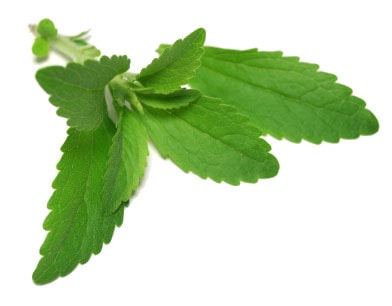
Written By: Sejal Dave, RD
Title: Registered Dietitian
Alumni: University of Florida
Last Updated on:

Stevia has been around for ages – centuries, actually. Now, stevia is being marketed as a new and improved sweetener – or, rather, a pure and true one, as the brand names PureVia and Truvia suggest. These products contain Rebiana (also known as RebA), the “sweetest” part of the stevia leaf.

Table of Contents
Stevia is a calorie-free sweetener that was discovered in Paraguay, South America. The natives of Paraguay used the leaves of the stevia plant in their meals to sweeten traditional foods and drinks such as mate (a bitter tea-like beverage).
In the twentieth century, French researchers identified steviol glycosides (such as RebA) as being responsible for the characteristic sweet taste of the stevia plant. In recent years, stevia-based sweeteners have been available in several countries in South America and around the world, where they have generally been used in to sweeten sodas and candy. In the US and Canada, however, stevia was historically sold as a dietary supplement rather than a sweetening agent. But that has recently changed: in December 2008, stevia was given the thumbs-up to be used as a sweetener by the FDA. It is now considered GRAS (generally regarded as safe) and is quickly increasing in popularity among food manufacturers.
In the past, stevia-derived sweeteners, in powder and liquid form, were limited to being sold in health food stores. Now, products like PureVia and Truvia are available at Walmart, Whole Foods stores, and directly online. PureVia, which is affiliated with PepsiCo, has already launched a line of stevia-based drinks called SoBe Life Waters. Truvia is manufactured, in part, by Coca-Cola, which may mean that new calorie-free beverages are just around the corner. Both PureVia and Truvia are sold in packets that can be easily taken along with you. Also, similar to other sweeteners on the market (like Splenda and Equal) Truvia is heat stable so it can be used for baking and cooking.
Critics, however, are not excited about stevia’s approval. They suggest that stevia given the thumbs-up by the FDA in an effort to please the food service industry. Companies like Cargill and PepsiCo have a vested interest in stevia and have moved quickly to launch stevia-containing beverages. Is this a coincidence? Despite FDA approval, there’s controversy about the lack of research that’s been done to investigate the possible long-term side effects of stevia on consumer health. The Center for Science in the Public Interest, in particular, has raised concerns that stevia may cause DNA damage.
Stevia does not have an impact on blood glucose levels. It has zero carbohydrates or calories, and can be used as a sugar substitute or alternative sugar sweetener as part of a healthy diabetes meal plan.
Now that the FDA has given stevia the green light, stevia-based products are popping up everywhere. They offer yet another option to people with diabetes looking for low-sugar foods and beverages. Whether you are trying to manage your diabetes or just looking for a low-sugar product, it’s best to stick to natural whole foods and consume fewer packaged foods.
Alumni: University of Florida – Sejal is a registered dietitian, a certified diabetes educator and she holds a masters degree in nutrition and health. Sejal was the project coordinator for the Veteran’s Administrations (VA) national weight loss program and previously worked for the VA hospital in Tampa, FL as a Spinal Cord Injury dietitian.
Sejal has had numerous clinical and community education experiences, including pediatric and intensive care nutrition support. She has also had the opportunity to teach nutrition courses at the community college level to students interested in pursuing health professions. One of her favorite areas of education is diabetes management.
artificial sweeteners, blood sugar, diabetes, diabetes diet, stevia, sugar, sweeteners